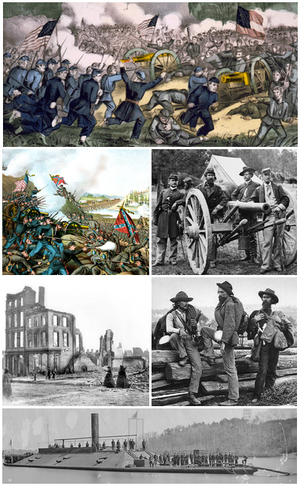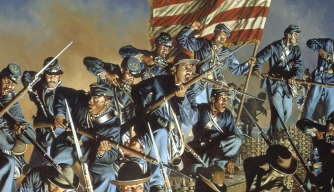American Civil War
The American Civil War, widely known in the United States as simply the Civil War as well as other names, was a civil war
fought from 1861 to 1865 to determine the survival of the Union or
independence for the Confederacy. Among the 34 states in January 1861,
seven Southern slave states individually declared their secession from the United States of America and formed the Confederate States of America. The Confederacy, often simply called the South,
grew to include eleven states, and although they claimed thirteen
states and additional western territories, the Confederacy was never
diplomatically recognized by any foreign country. The states that
remained loyal and did not declare secession were known as the Union or the North. The war had its origin in the factious issue of slavery, especially the extension of slavery into the western territories.[N 1]
After four years of combat, which had left up to 750,000 Americans,
Union and Confederate, dead and had destroyed much of the South's
infrastructure, the Confederacy collapsed and slavery was abolished.
Then began the Reconstruction and the processes of restoring national unity and guaranteeing civil rights to the freed slaves.
 | |
| Clockwise from top: Battle of Gettysburg, Union Captain John Tidball's artillery, Confederate prisoners, ironclad USS Atlanta, ruins of Richmond, Virginia, Battle of Franklin |
History
In the 1860 presidential election, Republicans, led by Abraham Lincoln, supported banning slavery in all the U.S. territories, something the Southern states viewed as a violation of their constitutional rights and as being part of a plan to eventually abolish slavery. The Republican Party, dominant in the North, secured a majority of the electoral votes, and Lincoln was elected the first Republican president, but before his inauguration, seven slave states with cotton-based economies formed the Confederacy. The first six to secede had the highest proportions of slaves in their populations, a total of 48.8 percent.Eight remaining slave states continued to reject calls for secession. Outgoing Democratic President James Buchanan and the incoming Republicans rejected secession as illegal. Lincoln's March 4, 1861 inaugural address declared his administration would not initiate civil war. Speaking directly to "the Southern States," he reaffirmed, "I have no purpose, directly or indirectly to interfere with the institution of slavery in the United States where it exists. I believe I have no lawful right to do so, and I have no inclination to do so."[13] Confederate forces seized numerous federal forts within territory claimed by the Confederacy. Efforts at compromise failed, and both sides prepared for war. The Confederates assumed that European countries were so dependent on "King Cotton" that they would intervene; none did, and none recognized the new Confederate States of America.Hostilities began on April 12, 1861, when Confederate forces fired upon Fort Sumter. While in the Western Theater the Union made significant permanent gains, in the Eastern Theater, battle was inconclusive in 1861–62. The autumn 1862 Confederate campaigns into Maryland and Kentucky failed, dissuading British intervention.[citation needed] Lincoln issued the Emancipation Proclamation, which made ending slavery a war goal. To the west, by summer 1862 the Union destroyed the Confederate river navy, then much of their western armies and seized New Orleans. The 1863 Union siege of Vicksburg split the Confederacy in two at the Mississippi River. In 1863, Robert E. Lee's Confederate incursion north ended at the Battle of Gettysburg. Western successes led to Ulysses S. Grant's command of all Union armies in 1864. Inflicting an ever-tightening naval blockade of Confederate ports, the Union marshaled the resources and manpower to attack the Confederacy from all directions, leading to the fall of Atlanta to William T. Sherman and his march to the sea. The last significant battles raged around the Siege of Petersburg. Lee's escape attempt ended with his surrender at Appomattox Court House, on April 9, 1865. While the military war was coming to an end, the political reintegration of the nation was to take another 12 years of the Reconstruction Era.
The American Civil War was one of the earliest true industrial wars. Railroads, the telegraph, steamships, and mass-produced weapons were employed extensively. The mobilization of civilian factories, mines, shipyards, banks, transportation and food supplies all foreshadowed the impact of industrialization in World War I. It remains the deadliest war in American history. From 1861 to 1865, it has been traditionally estimated that about 620,000 died but recent scholarship argues that 750,000 soldiers died, along with an undetermined number of civilians. By one estimate, the war claimed the lives of 10 percent of all Northern males 20–45 years old, and 30 percent of all Southern white males aged 18–40.
 | |
| Bodies in front of the Dunker Church - Antietam Battlefield (Library of Congress) |
 | |
| Black Civil War Soldiers |
Video
No comments:
Post a Comment